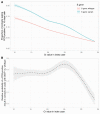Severe Acute Respiratory Syndrome Coronavirus 2 (SARS-CoV-2) Infectivity by Viral Load, S Gene Variants and Demographic Factors, and the Utility of Lateral Flow Devices to Prevent Transmission
- PMID: 33972994
- PMCID: PMC8136027
- DOI: 10.1093/cid/ciab421
Severe Acute Respiratory Syndrome Coronavirus 2 (SARS-CoV-2) Infectivity by Viral Load, S Gene Variants and Demographic Factors, and the Utility of Lateral Flow Devices to Prevent Transmission
Abstract
Background: How severe acute respiratory syndrome coronavirus 2 (SARS-CoV-2) infectivity varies with viral load is incompletely understood. Whether rapid point-of-care antigen lateral flow devices (LFDs) detect most potential transmission sources despite imperfect clinical sensitivity is unknown.
Methods: We combined SARS-CoV-2 testing and contact tracing data from England between 1 September 2020 and 28 February 2021. We used multivariable logistic regression to investigate relationships between polymerase chain reaction (PCR)-confirmed infection in contacts of community-diagnosed cases and index case viral load, S gene target failure (proxy for B.1.1.7 infection), demographics, SARS-CoV-2 incidence, social deprivation, and contact event type. We used LFD performance to simulate the proportion of cases with a PCR-positive contact expected to be detected using 1 of 4 LFDs.
Results: In total, 231 498/2 474 066 (9%) contacts of 1 064 004 index cases tested PCR-positive. PCR-positive results in contacts independently increased with higher case viral loads (lower cycle threshold [Ct] values), for example, 11.7% (95% confidence interval [CI] 11.5-12.0%) at Ct = 15 and 4.5% (95% CI 4.4-4.6%) at Ct = 30. B.1.1.7 infection increased PCR-positive results by ~50%, (eg, 1.55-fold, 95% CI 1.49-1.61, at Ct = 20). PCR-positive results were most common in household contacts (at Ct = 20.1, 8.7% [95% CI 8.6-8.9%]), followed by household visitors (7.1% [95% CI 6.8-7.3%]), contacts at events/activities (5.2% [95% CI 4.9-5.4%]), work/education (4.6% [95% CI 4.4-4.8%]), and least common after outdoor contact (2.9% [95% CI 2.3-3.8%]). Contacts of children were the least likely to test positive, particularly following contact outdoors or at work/education. The most and least sensitive LFDs would detect 89.5% (95% CI 89.4-89.6%) and 83.0% (95% CI 82.8-83.1%) of cases with PCR-positive contacts, respectively.
Conclusions: SARS-CoV-2 infectivity varies by case viral load, contact event type, and age. Those with high viral loads are the most infectious. B.1.1.7 increased transmission by ~50%. The best performing LFDs detect most infectious cases.
Keywords: B.1.1.7 variant; SARS-CoV-2; contact tracing; infectivity; lateral flow device.
© The Author(s) 2021. Published by Oxford University Press for the Infectious Diseases Society of America.
Figures





References
-
- Grasselli G, Pesenti A, Cecconi M. Critical care utilization for the COVID-19 outbreak in Lombardy, Italy: early experience and forecast during an emergency response. JAMA 2020; 323:1545–6. - PubMed
Publication types
MeSH terms
Supplementary concepts
Grants and funding
LinkOut - more resources
Full Text Sources
Other Literature Sources
Medical
Miscellaneous

